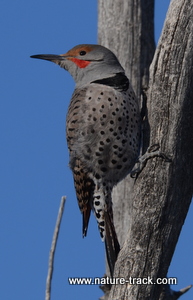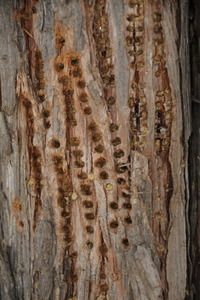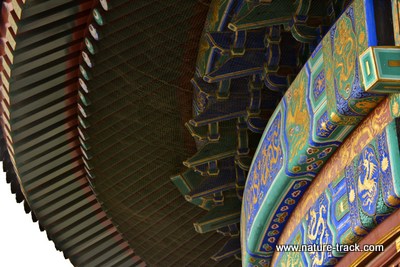Living With Woodpeckers

This male Northern flicker is an extraordinarily handsome bird.
The female Northern Flicker gathered sunflower seeds from beneath my feeder as she had done off and on for the last month. I watched her through binoculars as usual, but this time the sight of her agitated a sliver of a memory long since suppressed by the weightier matters of life.
The recollection was faint at first, but the fragments slowly coalesced as I closed my eyes and drifted back through 30 years of haze. Once there, I saw another female flicker, a beautiful bird about the size of a mourning dove. Her splendid spotted breast, black bib, and barred wings and back were accentuated by a beautiful orange hue underneath. So beautiful, and so hard to dislike if it weren’t for one annoying habit: she liked to peck at the stucco on the house. This time, she had created a hole through the gable and was now collecting material for her nest inside the attic. She likely considered it the perfect nesting site—no cats or squirrels were likely to bother her babies.
And that had eventually put us on opposite sides of a .22 rifle loaded with birdshot. As a brand new homeowner, I was intolerant of home invasion of any sort. I could not appreciate her beauty or her cleverness—she had violated my home and that was that. I planned to resolve the issue the same way Grandpa handled cherry thieving robins—I was even using the same gun.
When I poked the rifle barrel through the attic access, I could see her silhouetted by the light streaming in through the hole she had made. The tiny pellets in the .22 caliber birdshot did their job and I retrieved the warm body of the feathered interloper without remorse, patched the hole to discourage others, and hurried off to class to learn about wildlife management.
Woodpeckers, including the beautiful flicker, are amazing and wonderful birds. My wife and I probably get more pleasure from seeing and watching the various species than any other birds. Most of the time, they perform a service to us by removing insects from trees and incidentally creating habitat for a host of birds and mammals that use the holes they excavate. We currently have hairy and downy woodpeckers and a northern flicker using our suet feeders and are thrilled that they are willing to grace our yard with their presence.
However, and there is always a however, woodpeckers aren’t always graceful visitors and living in harmony with woodpeckers requires some creativity and more than a little patience at times.
Like in my story, humans and woodpeckers get crosswise when woodpeckers decide to share or attempt to share human habitation or attack sheds or even live trees. Don’t get me wrong: woodpeckers are well armed and can cause real damage to a building. Humans aren’t being unreasonable to want to correct bad habits woodpeckers might have.
Woodpecker damage or annoyance (their incessant hammering is taxing) can often be alleviated with a simple approach: make the area where they want to be hard to get to. The most important part of this is to do it as soon as you notice the damage. Don’t wait for them to form the habit or you may see them just move off the protected area and start again.
Sapsuckers are the most likely to damage living trees. They drill dozens of small holes in the bark of a tree and lick up the sap as it flows out. This type of damage is easily thwarted by wrapping the tree with quarter inch hardware cloth. This is essentially heavy wire screen with quarter inch-sized holes.

Holes drilled by a sapsucker looking for a sugary treat. Personally, so long as the tree isn't permanently damaged by the drilling, I find the holes unique and a sign that nature is working. However, there are others who may consider the holes unsightly or, the excessive drilling may actually weaken the tree or make it susceptible to pathogen attack.
Other woodpeckers will readily attack buildings. To protect buildings, hardware cloth tacked over the affected area will usually stop even the most diligent attack. However, it isn’t the prettiest thing you could do to dress up your home. Plastic netting installed from eave to wall is often less noticeable. You can see an example from the Summer Temple in Beijing, China.

The netting is on the middle portion. If you have a hard time seeing it, it proves the point that it is actually unobtrusive.
Yet another way to encourage woodpeckers, especially hairy and downy woodpeckers, to go elsewhere is to create a woodpecker bong. Woodpeckers make their incessant hammering noise as part of their mating ritual. All they want is something that resonates the sound of their hammering. A bong serves that purpose.
A bong is made from three pieces of 1”x4”x3’ pine or cedar boards fastened together to create a U. the U is then centered and attached, hollow side to a back board that is 1”x4”x4’, forming a hollow rectangular tube. The entire bong is then attached to a location that will be less disturbing than your siding. Woodpeckers will find the bong has a very satisfying tone and will likely abandon your house for the better instrument.
Most forms of visual deterrents such as plastic owls or streamers are ineffective in deterring woodpeckers. They figure out very quickly what to fear and what to ignore. Applications of sticky substances is said to be somewhat of a deterrent as the birds don’t like the stickiness on their feet. However, most products that you can apply may discolor wood, paint or plastic and may run in warm weather leaving ugly streaking. Your best bet is to prevent the birds from gaining access to the area you want protected.
However, a friend of mine tells me that he has good luck deterring flickers from attacking his gables by fastening long strips of engineering flagging to his siding with thumbtacks. The ribbon dances on the wind and apparently makes the birds nervous.
Just remember that all woodpeckers are protected species and cannot be shot as I did in my less enlightened days.